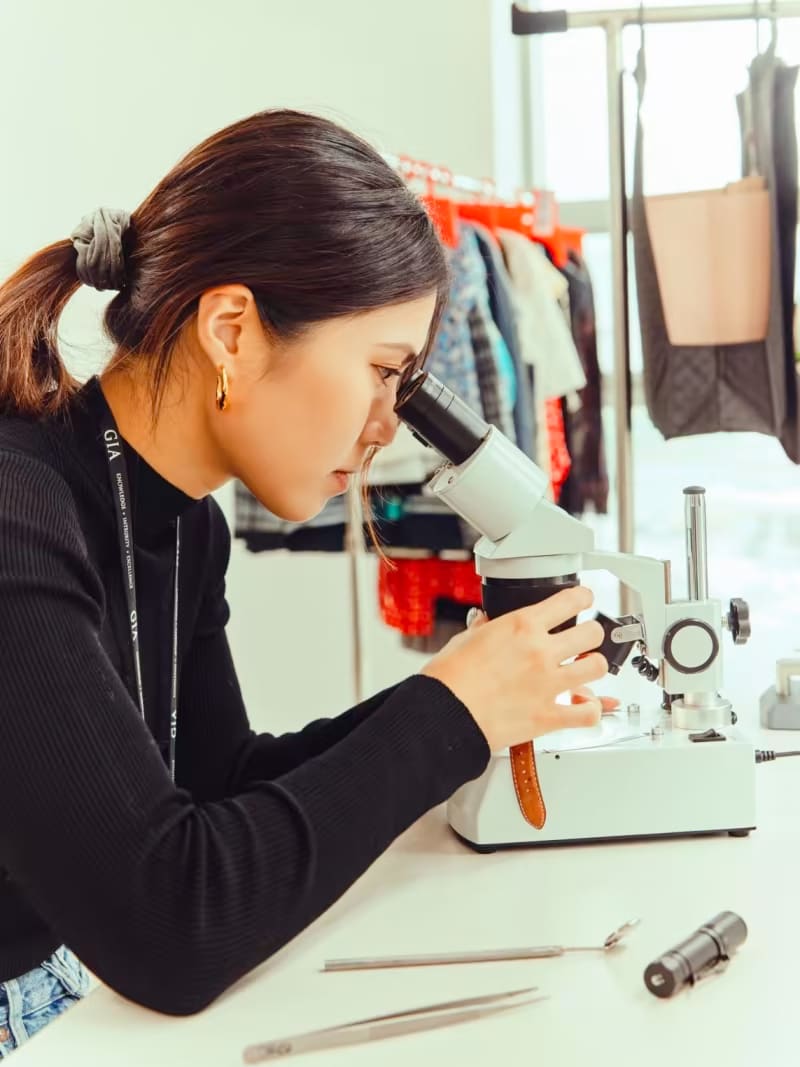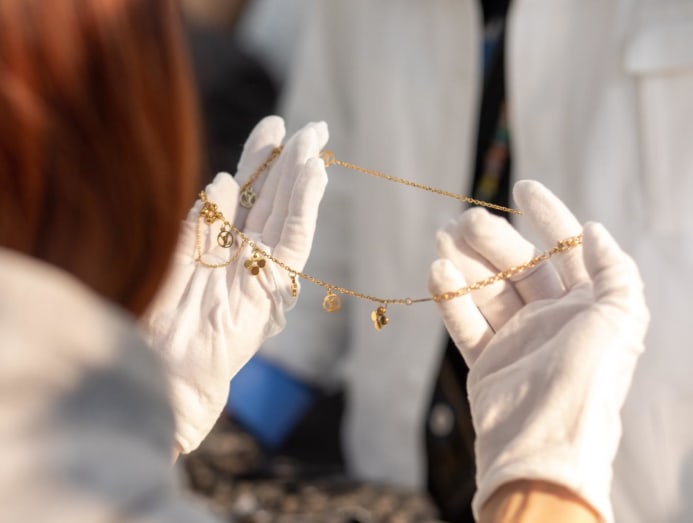She’s mastered the art of spotting fake luxury goods: Meet an authenticator from Vestiaire Collective
Vestiaire Collective’s authenticator Kai Ning tells CNA Lifestyle how the tell-tale signs of top-graded counterfeit items are often hidden in the details.

Vestiaire Collective authenticator Kai Ning at work. (Photo: Vestiaire Collective)
The global second-hand market is expected to hit US$350 billion (or S$469.49 billion) by 2027. And according to online second-hand platform Thredup’s 2023 annual resale report, it will be Gen Z and millennial consumers who will account for nearly two-thirds of this increased spending.
After all, in 2022 alone, it found that two out of every five items in a Gen Z-er’s closet was pre-loved.
And when it comes to second-hand luxury goods, specifically, research company ResearchAndMarkets.com is predicting the market to hit US$51 billion by 2028.
Whether it’s to fulfil a desire for luxury designer pieces, a love for vintage or to lead a more sustainable, waste-not life, it all contributes to how the second-hand market has become a part of the mainstream fashion world.
So where do we go to get these pre-loved pieces?
Today, there are many different offline and online options. Even big brands have joined the bandwagon. In the US, Nordstrom launched See You Tomorrow, an online marketplace that also has an in-store presence in its NYC flagship store offering pre-owned apparel and accessories. In the UK, Selfridges has a similar set-up, with its Reselfridges that is available both online and offline in its London flagship store.
And of course, there is Vestiaire Collective, the leading global online marketplace offering luxury resale and desirable pre-loved items, from ready-to-wear fashion and jewellery to bags and shoes. Besides the website, there’s also an app to make late-night in-bed browsing and shopping even easier.
THE NEED FOR AUTHENTICATORS
But when it comes to shopping for pre-loved pieces, what many are often concerned with is how authentic the items are. Fortunately, the guesswork is taken care of by credible authenticators, of which Vestiaire Collective has over 80 digital and physical authenticators.
According to one of their authenticators, Kai Ning, being one is not just about knowledge or expertise, but having a passion too. “We use all of our senses, from sight to hearing, smelling and touching to perform the job. Eventually, even your senses start building ‘muscle memory’ and help you remember how an authentic item should look, sound, smell and feel.”

The Central Saint Martins graduate likened authentication as an investigation. “Each element and checkpoint helps to confirm if an item is authentic or not. If you are able to authenticate a real item, you will therefore be able to detect a counterfeit, however the reverse is not true.”
For instance, Kai Ning also explained that authentication of certain items, such as gems, can be challenging due to varying quality standards of these categories. However, with the right set of skills, along with multiple checkpoints and the use of sophisticated instruments, we are able to spot the subtle differences between genuine and counterfeit pieces, she stated.
BEING A VESTIAIRE COLLECTIVE AUTHENTICATOR

With her background in jewellery design, gemmology (GIA) and watch advising (FHH), Kai Ning started out as an account manager at the consignment department visiting clients’ houses and helping them clean out their closets. From there, she moved to the authentication department in the Hong Kong office.
In August 2022, Kai Ning relocated to the new Vestiaire Collective authentication centre in Seoul, South Korea. She is currently focusing on gemmology, developing more in-depth training materials to train the next cohort of authentication trainees.
So what’s the most unique item she’s authenticated thus far?

“A Jean-Charles de Castelbajac teddy bear jacket from the 1980s that cost around S$10,000, and which has approximately 17 teddy bears sewn onto it. This jacket model was also on display in museums such as the Rhode Island School of Design Museum in the United States and the National Gallery of Victoria, Australia.”
Another interesting item that passed through her hands was a positive pregnancy test kit that was found in a bag the team authenticated. It was a win-win situation as congratulations were sent to the seller for the good news and for successfully selling her bag.
REAL VS FAKE: SIGNS TO SPOT
When asked if she would be able to spot a fake from afar, Kai Ning asserted that she would have no trouble in doing so. It’s something every Vestiaire Collective authenticator is expected to do with ease.
In fact, in 2022, the Vestiaire Collective digital authentication team rejected 8 per cent of the items sent in via photographs for being non-compliant.

“Authentication means verifying brand standards, so you first have to understand the brand standards depending on the line, category and period. For example, haute couture line versus sports line, bags versus ready-to-wear, or vintage versus contemporary. Understanding the quality of a material and finishes is fundamental. Luxury is the definition of attention to detail.”
And it is for this reason that it is still crucial for an item to be examined physically by an authenticator. Added Kai Ning: “For the top-graded counterfeit items, the tell-tale signs are often hidden in the details”.

For instance, for bags, how it smells is very important, while for watches and jewellery, the weight of an item is usually the first tell-tale sign.
Fun fact: Kai Ning actually has her own personal collection of “Real vs Fake” Instagram stories that she’s spotted on the streets.
So with better and improved quality of counterfeit products becoming more prevalent in the market, does it make Kai Ning’s job more difficult?
“It does not necessarily make it harder as a professional in the field, but it does make our job as authenticators more important. Whilst an untrained person might possibly miss out on spotting non-compliant details, our years of training and experience enable us to pick up on the quality of a product. As the counterfeiters’ skills improve with time, we also improve by learning from them.”
THE SKILLS YOU’LL NEED
This begs the question: Can anyone be an authenticator?
In addition to fashion knowledge and passion being key, Kai Ning shared that Vestiaire Collective has a rigid recruitment process that includes a practical test that will validate your knowledge and level of expertise and skills.
“Although it is impossible to learn authentication at school, your fashion knowledge on brands’ history and craftsmanship along with your personal traits such as being detail-oriented, analytical and well-organised would position you as a great candidate.”

Once in, you’ll continue to improve existing skill sets and acquire new ones. “Before we deep dive into our respective specialty, every authenticator follows the same rigorous training of brands and categories. As we progress, we then have the flexibility to explore our main interest and expertise area.”
And because authentication isn’t something you can learn in school, Vestiaire Collective has also created an internal training hub, the Vestiaire Academy, which offers a variety of courses to train their authentication trainees. “This involves two months of rigorous authentication training followed by continuous training to stay up-to-date with our knowledge and expertise.”

After graduating from these courses, the Vestiaire Collective trainees are then closely guided by the senior authenticators for a further six months to one year to ensure that they are ready to be fully autonomous, explained Kai Ning.
Authenticators also have access to other courses that can help deepen their understanding of other categories to grow their expertise. For Kai Ning, she chose to take a horology course at the Fondation de la Haute Horlogerie to gain further insight into the watch world.
But more important, Kai Ning added that as authenticators, it is also important to stay updated with new brands, trends, collaborations and collections that are released. And for this reason, the Vestiaire Collective authenticators also receive regular upskill training focusing on these topics for 180 hours annually too.

Ultimately, you will learn a lot during the training, but after that, it is all about practising, doing research and learning from the item itself, she added.
THE SKILLS YOU’LL TAKE WITH YOU
And when it comes to buying apparel or accessories for herself, Kai Ning said that the skills she’s acquired has definitely given her a greater appreciation for the craft and skill that goes behind item made.
“Vestiaire Academy taught me not only to identify counterfeits, but truly appreciate the craftsmanship and material used to create these luxury fashion pieces. It showed me how meticulous artistry could set itself apart from fast fashion, an item that lasts one to two years versus an item that could last for more than half a decade.”
Read this story in Bahasa Indonesia here.






